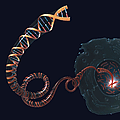"The importance of deoxyribonucleic acid (DNA) within living cells is undisputed" (Watson & Crick, 1953). This opening sentence of James Watson and Francis Crick's second major paper, published shortly after the announcement of their proposed structure for the genetic material, has proven to be an understatement. Today, it is readily apparent that Watson and Crick's breakthrough set off a firestorm of discovery and innovation that has continued for over 50 years.
The material in this set of articles describes the science surrounding the structure and function of DNA. Here, you will find information on the chemical structure of DNA; details about the organization of DNA into chromosomes, genes, and gene families; and data regarding important categories of sequences within DNA, such as introns, exons, promoters, telomeres, and centromeres.
As pointed out by Watson and Crick, the structure of DNA is central to its function, namely its duplication and its expression of the information contained in its nucleotide sequence. Thus, these articles explore both functions, taking a close look at the processes of DNA replication, transcription, and translation.
Changes in the DNA sequence lead to most of the genetic disorders that affect humans and other organisms. Learning how these "mutations" cause disease allows investigators to more accurately diagnose and treat various disorders. Furthermore, researchers' ability to manipulate the genetic sequence has given rise to a new set of powerful technologies and industries that are collectively known as biotechnology. Such advances and techniques are also explored in depth throughout this set of articles.
Image: National Human Genome Research Institute.













